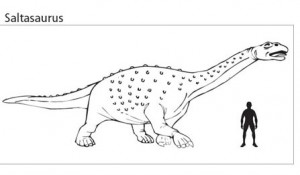More evidence of Dinosaurs in New Zealand
The fossil record for dinosaurs in New Zealand is particularly poor. Dinosaur remains are few and far between in this country, although a number of marine reptile fossils have been discovered in recent years. Some fossils of marine reptiles, are much more complete and have enabled scientists to classify them as a separate and distinct genus unique to New Zealand, to date a mosasaur and a plesiosaur have been named and described.
Animals that die in a marine environment have a higher chance of fossil preservation, the conditions permit fossilisation to take place (presence of conditions to allow the rapid deposition of sediments and such like). With New Zealand’s dinosaurs, what fossils that have been found are usually isolated bones, often in a poor state of preservation, so at best only classification to a Family level can be made. For much of New Zealand’s history it was attached to the continent of Australia, which itself formed part of a much larger southern super-continent called Gondwanaland. Dinosaurs were theoretically able to roam from the western coast of south America right across to the east coast of New Zealand. Some fragmentary fossils of dinosaurs (dating from the Cretaceous), have been found, scientists are confident that there were carnosaurs (meat-eaters), probably members of the Allosauridae, as well as plant-eaters such as ankylosaurs and hypsilophodontids. The presence of coal seams, formed in the Mesozoic in New Zealand indicate that the country was relatively tropical for much of the Age of Reptiles, even though the land mass that was to become New Zealand was much closer to the South Pole at this time in the Earth’s history.
Thanks to the devotion and dedication of a fossil hunter, a new type of dinosaur can be added to the fauna of New Zealand, evidence of giant titanosaurs roaming the region has been unearthed. Dr Joan Wiffen, a scientist and fossil collector has been studying the dinosaurs of this particular part of the world for many years. Now into her eighties, she shows no signs of slowing down and has not lost any of her enthusiasm for the subject. With her colleagues, Dr Wiffen has been responsible for identifying six different kinds of dinosaurs indigenous to New Zealand.
The titanosaur fossil (believed to be part of the caudal vertebrae) consists of a single, heavily eroded bone that was found in a stream bed in the Hawke’s Bay region in 1999. Hawke’s Bay is situated on the eastern coast of the North Island, the paper on this particular fossil has only just been published after a period of research and peer review, but this is the first evidence of titanosaurs inhabiting the country.
Titanosaurs, were a branch of the Sauropoda, the large, long-necked herbivorous dinosaurs. Although the ornithopods dominated eco-systems in the Northern Hemisphere and sauropods became increasingly rare in the Cretaceous, in the southern latitudes the sauropods, in the form of titanosaurs continued to flourish. Titanosaurs were the last sauropods to evolve, appearing some time in the Late Jurassic and surviving right until the end of the Cretaceous 65 million years ago. Some titanosaurs can stake a claim to being the largest creatures ever to walk on land, Argentinosaurus (from Argentina), is estimated to have been 30 metres in length and weighed 100 tonnes. Not only are these animals famous for their sheer size, but they are the only group of sauropods known for definite to have dermal body armour. The body armour consisted of hard plates (called scutes) that in many species was scattered over their backs and hind-quarters.
Saltasaurus (from the Salta Province in Argentina) is typical of the titanosaurs, with its dermal armour and typical titanosaur body shape of a long-neck and long-tail. At 12 metres and weighing perhaps as much as 8 tonnes this was no small dinosaur, but it would have been small in comparison to the giant titanosaurs such as Argentinosaurus, Alamosaurus, Andesaurus and Paralititan, all of which could have exceeded 30 metres in length.
A Picture of a Typical Titanosaur – Saltasaurus
Picture credit: Everything Dinosaur
To view a model of a titantosaur and other sauropods: CollectA Deluxe Prehistoric Life Dinosaur Models.
There is not much more that can be deduced from the fossil, other than to confirm that it is from a Titanosaur, scientists cannot be certain how big this dinosaur was as the bone could have come from a juvenile.
Dr Wiffen stated: “I saw a partly exposed concretion (sedimentary rock) about the size of a rugby ball in the stream bank. I dug it out and asked a colleague to break it open with a hammer. I immediately saw a bone structure inside that looked different from the bone of a marine reptile. To be honest it’s a fairly non-descript and incomplete bone. It is heavily eroded and that’s because it must have been transported in a riverbed for some time before it was buried”.
With fossil carefully wrapped, Dr Wiffen took it home and began to work on it in her garage which also serves as a fossil preparation laboratory. Using fine chisels and small picks she carefully removed the surrounding stone to expose the fossil. She even used dilute acetic acid to help dissolve away the rock to allow more of the fossil to come to light. Once prepared she took the bone to the Queensland Museum in Australia for examination by Dr Ralph Molnar, an authority on dinosaurs from Gondwanaland. It was Dr Molnar who confirmed that this fossil was of a tail bone from a titanosaurid.







Leave A Comment